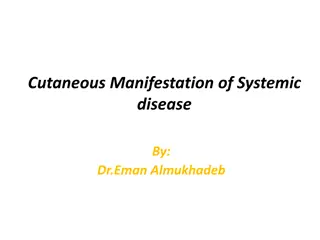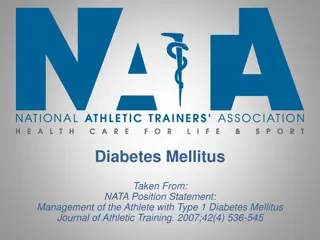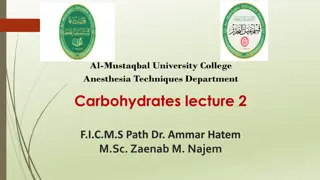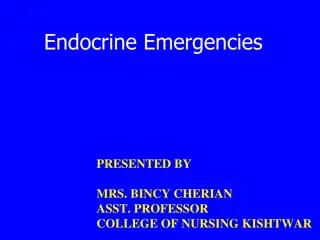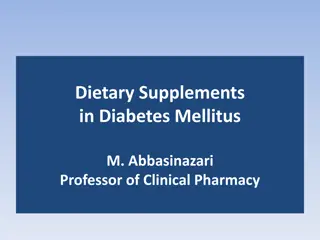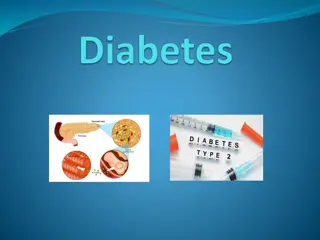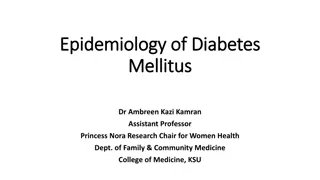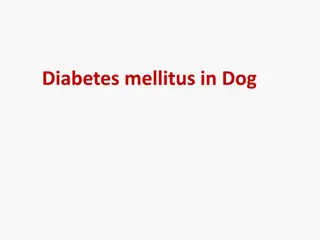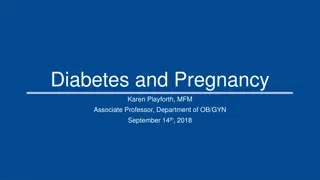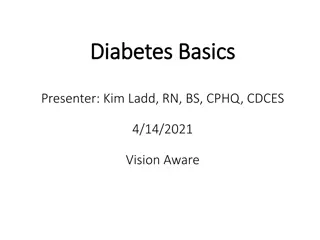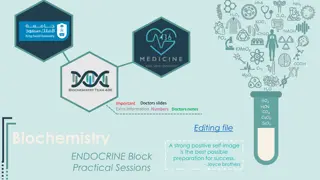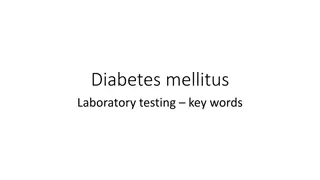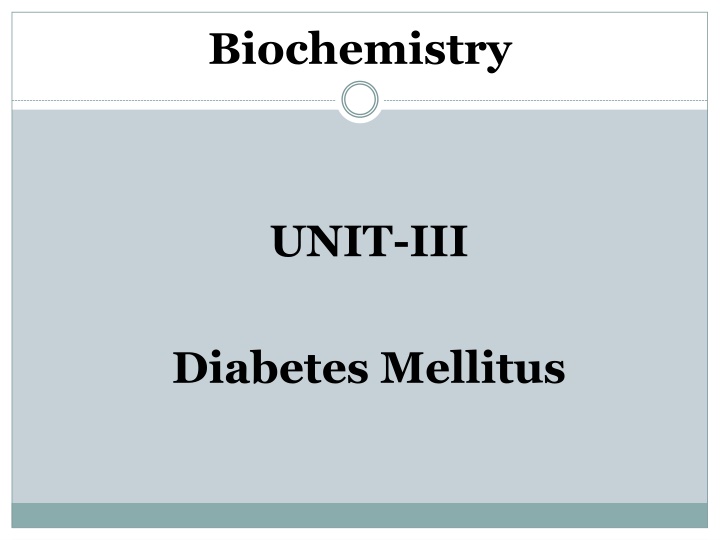
Diabetes Mellitus: Causes, Symptoms, and Management
Diabetes mellitus is a metabolic disorder characterized by high blood glucose levels due to defects in insulin production or action. This article explains the role of insulin, symptoms of diabetes, and altered carbohydrate and protein metabolism in the condition.
Download Presentation

Please find below an Image/Link to download the presentation.
The content on the website is provided AS IS for your information and personal use only. It may not be sold, licensed, or shared on other websites without obtaining consent from the author. If you encounter any issues during the download, it is possible that the publisher has removed the file from their server.
You are allowed to download the files provided on this website for personal or commercial use, subject to the condition that they are used lawfully. All files are the property of their respective owners.
The content on the website is provided AS IS for your information and personal use only. It may not be sold, licensed, or shared on other websites without obtaining consent from the author.
E N D
Presentation Transcript
Biochemistry UNIT-III Diabetes Mellitus
What is diabetes? Diabetes mellitus (DM) is a group of diseases characterized by high levels of blood glucose resulting from defects in insulin production, insulin action, or both The term diabetes mellitus describes a metabolic disorder of multiple aetiology characterized by chronic hyperglycaemia with disturbances of carbohydrate, fat and protein metabolism resulting from defects in insulin secretion, insulin action, or both The effects of diabetes mellitus include long term damage, dysfunction and failure of various organs
Insulin Produced by the cells in the islets of Langherans of the pancreas Promotes glucose transport from the bloodstream across the cell membrane to the cytoplasm of the cell Analogous to a key that unlocks the cell door to allow glucose inside Insulin after a meal: Stimulates storage of glucose as glycogen Inhibits gluconeogenesis Enhances fat deposition in adipose tissue Fasting state Counter-regulatory hormones (especially glucagon) stimulate glycogen glucose When glucose unavailable during fasting state Lipolysis (fat breakdown) Proteolysis (amino acid breakdown)
Symptoms Diabetes characteristic symptoms such as thirst, polyuria, blurring of vision, and weight loss In its most severe forms, ketoacidosis or a non ketotic hyperosmolar state may develop and lead to stupor, coma and, in absence of effective treatment, death Often symptoms are not severe, or may be absent, and consequently sufficient to cause pathological and functional changes may be present for a long time before the diagnosis is made mellitus may present with hyperglycaemia
ALTERED CHO METABOLISM Insulin Glucose Utilization + Glycogenolysis Hyperglycemia Glucosuria (osmotic diuresis) Polyuria* (and electrolyte imbalance) Polydipsia* * Hallmark symptoms of diabetes
ALTERED PROTEIN METABOLISM Insulin Protein Catabolism Gluconeogenesis (amino acids Hyperglycemia Weight Loss and Fatigue glucose)
ALTERED FAT METABOLISM Insulin Lipolysis Free fatty acids + ketones Acidosis + Weight Loss
Types of Diabetes Type 1 Diabetes Mellitus Type 2 Diabetes Mellitus
Type I diabetes Was previously called insulin-dependent diabetes mellitus (IDDM) or juvenile-onset diabetes Type 1 diabetes develops when the body s immune system destroys pancreatic beta cells, the only cells in the body that make the hormone insulin that regulates blood glucose This form of diabetes usually strikes children and young adults, although disease onset can occur at any age Type 1 diabetes may account for 5% to 10% of all diagnosed cases of diabetes Type 1 diabetes is common is dog
Type II diabetes Was previously called non-insulin-dependent diabetes mellitus (NIDDM) or adult-onset diabetes Type 2 diabetes may account for about 90% to 95% of all diagnosed cases of diabetes It usually begins as insulin resistance, a disorder in which the cells do not use insulin properly. As the need for insulin rises, the pancreas gradually loses its ability to produce insulin Type 2 diabetes is associated with older age, obesity, family history of diabetes, history of gestational diabetes, impaired glucose metabolism, physical inactivity, and race/ethnicity Type 2 diabetes is Common in Cat
Comparisons of Type 1 & Type 2 Type 1 (5-10%) Sudden onset Severe symptoms Weight loss Lean Ketosis Absent C-peptides Markers of autoimmunity present Family history uncommon Onset usually in the young Most common in dog Type 2 (90-95%) Gradual onset May be Asymptomatic Often no weight loss Usually obese Not ketotic C-peptide detectable No markers of autoimmunity present Family history Onset usually >40 years old Most common in dog
Diagnosis Blood glucose Fasting blood glucose-less than 120mg/dl Post-prandial (PP) glucose-less than 140mg/dl Renal threshold level- 180 mg/dl Urine glucose Glucose is present in urine when blood glucose level exceeds renal threshold level Benedict test
Glucose tolerance test (GGT) Oral Glucose tolerance test (OGGT) Intravenous Glucose tolerance test (IGGT)
Oral Glucose tolerance test Overnight (at least 12 hr) fasting state Oral glucose bolus of 4 g/kg body weight given as a 50% w/v solution Blood and urine samples are collected at 30 minute intervals for at least 180 minutes Blood samples are subjected to glucose estimation Urine samples are qualitatively tested for glucose
Fasting plasma glucose level is 80 120 mg/dl Peak value (140 mg/dl) is reached in less than an hour Returns to normal by 2 hours Glucose is not detected in any of the urine samples
Intravenous Glucose tolerance test (IGGT) Overnight (at least 12 hr) fasting state Glucose bolus of 500 mg/kg body weight as a 50% solution, administered into a cephalic forelimb vein over 30 s Blood and urine samples are collected at 15 minute intervals for at least 120 minutes Blood samples are subjected to glucose estimation Urine samples are qualitatively tested for glucose.
Insulin Tolerance test Overnight (at least 12 hr) fasting state 0.1 unit of crystalline zinc insulin per kilogram body weight is injected intramuscularly Blood and urine samples are collected at 30 minute intervals for at least 180 minutes Blood samples are subjected to glucose estimation
Normally, blood level falls to 50% of its fasting level in 20-30 minutes and returns to its fasting level in 1.5-2 hours the glucose
Hemoglobin Alc Glycated or glycosylated hemoglobin refers to the glucose derived products hemoglobin (HbA) Glycation is a post-translational, nonenzymatic addition of sugar residue to amino acids of proteins Among the glycated hemoglobins, the most abundant form is HbA1c In the case of canine HbAlc where the canine erythrocyte has a lifespan of 100 days and a half-life of about 60 days, HbAlc reflects the average blood glucose over the previous 2 months prior to sampling of normal adult
Hemoglobin Alc In the cat, with an erythrocyte lifespan of 70 days and a half-life of about 40 days, HbAlc could be used as a measure of the average blood glucose over the previous 6 weeks. Normally, HbA1c concentration is about 3 5% of the total hemoglobin In diabetic patients, HbA1c is elevated (to as high as 15%)
Fructosamine Glycated serum proteins (fructosamine) can also be measured in diabetics Total serum proteins or albumin have life span and half-lives of 2-3 weeks and 7-9 day fructosamine can be used to mesure average blood glucose over the previous 2 weeks
Microalbuminuria Microalbuminuria is defined as the excretion of 30-300 mg of al Predicts impairment in renal function in diabetic patientsbumin in urine per day Serum lipid profile: Triglycerides, Cholesterol, LDL, VLDL, HDL


